Bosch B21CT80SNB, B21CT80SNS Instruction Manual
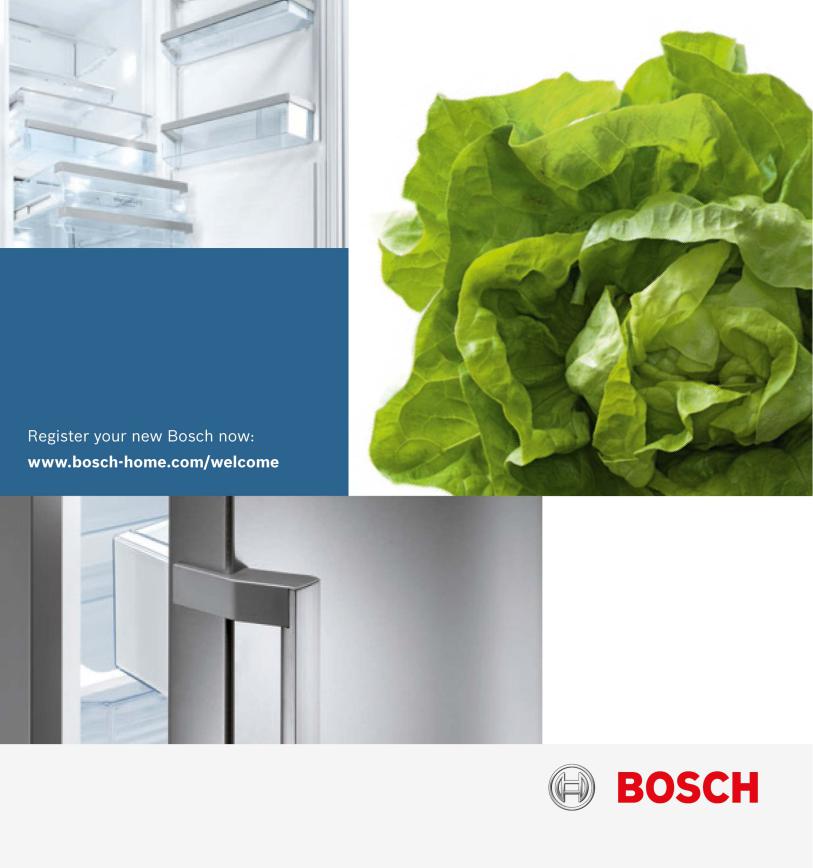
B21CT80SNS
B21CT80SNB
en Operating and installation |
es Instrucciones de uso y de |
instructions |
montaje |
fr Notices d'utilisation et de |
|
montage |
|

en Table of Contentsà . . . 3
fr Table des matièresà . . . 25
es Índiceà . . . . . . . . . . . . . . 47

en Table of ContentsÃ
IMPORTANT SAFETY INSTRUCTIONS . . . . . . . . 4 Disposal information . . . . . . . . . . . . . . . . . . . . . . . . 5 Scope of Delivery . . . . . . . . . . . . . . . . . . . . . . . . . . . 6 Installing the appliance . . . . . . . . . . . . . . . . . . . . . . 6 Aligning the appliance . . . . . . . . . . . . . . . . . . . . . . . 7 Connecting the appliance . . . . . . . . . . . . . . . . . . . 7 Installing the handles . . . . . . . . . . . . . . . . . . . . . . . 9 Appliance and Installation Dimensions . . . . . . . . 10 Getting to know your appliance . . . . . . . . . . . . . . 11 Control and display panel . . . . . . . . . . . . . . . . . . . 12 Operating tips . . . . . . . . . . . . . . . . . . . . . . . . . . . . . . 13 Switching on the appliance . . . . . . . . . . . . . . . . . . 13 Setting the temperature . . . . . . . . . . . . . . . . . . . . . 13 Temperature unit . . . . . . . . . . . . . . . . . . . . . . . . . . . 14 Super Freeze . . . . . . . . . . . . . . . . . . . . . . . . . . . . . . . 14 Super Cool . . . . . . . . . . . . . . . . . . . . . . . . . . . . . . . . . 15 Eco Mode . . . . . . . . . . . . . . . . . . . . . . . . . . . . . . . . . . 15 Refrigerator compartment . . . . . . . . . . . . . . . . . . . 15
en-us
Fresh food compartment . . . . . . . . . . . . . . . . . . . . 16 Freezer compartment . . . . . . . . . . . . . . . . . . . . . . . 16 Freezing food . . . . . . . . . . . . . . . . . . . . . . . . . . . . . . 16 Freezing fresh food . . . . . . . . . . . . . . . . . . . . . . . . . 17 Thawing frozen food . . . . . . . . . . . . . . . . . . . . . . . . 17 Ice maker . . . . . . . . . . . . . . . . . . . . . . . . . . . . . . . . . . 17 Water filter . . . . . . . . . . . . . . . . . . . . . . . . . . . . . . . . . 18 Performance data sheet . . . . . . . . . . . . . . . . . . . . 19 Interior Fittings . . . . . . . . . . . . . . . . . . . . . . . . . . . . . . 20 Switching off and disconnecting the appliance . 21 Defrosting . . . . . . . . . . . . . . . . . . . . . . . . . . . . . . . . . . 21 Cleaning . . . . . . . . . . . . . . . . . . . . . . . . . . . . . . . . . . . 21 LED light . . . . . . . . . . . . . . . . . . . . . . . . . . . . . . . . . . . 22 Energy saving tips . . . . . . . . . . . . . . . . . . . . . . . . . . 22 Operating noises . . . . . . . . . . . . . . . . . . . . . . . . . . . 22 Before Calling for Service . . . . . . . . . . . . . . . . . . . 23 Customer Service . . . . . . . . . . . . . . . . . . . . . . . . . . . 24
3
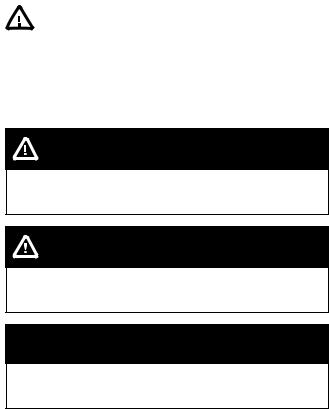
en-us
IMPORTANT SAFETY INSTRUCTIONS
READ AND SAVE THESE INSTRUCTIONS!
Definitions
WARNING
This indicates that death or serious injuries may occur as a result of not observing this warning.
CAUTION
This indicates that minor to moderate injuries may occur as a result of not observing this warning.
NOTICE
This indicates that damage to appliance or property may occur as a result of not observing this warning.
WARNING: Before you turn on the appliance
Please read the Operating and Installation Instructions carefully, including the following. They contain important safety information and instructions for installation, use and maintenance of the appliance. Retain all documents for subsequent use or for the next owner.
Technical safety
Improper installations and repairs may put the user at risk.
Repairs must be performed by an authorized service provider.
Only use original parts supplied by the manufacturer. Only original manufacturer supplied parts satisfy safety requirements.
If the power cord of this appliance is damaged, it must be replaced by an authorized servicer.
The appliance comes with a UL listed 3-wire Power Cord.
Never sever or remove the third (ground) conductor from the power cord.
The appliance requires a 3-wire receptacle. The plug must be installed by a licensed electrician only and comply with local codes.
Where there is a 2-wire standard wall receptacle, it is the responsibility of the customer to have this receptacle replaced with a correctly grounded 3-wire wall receptacle. Do not use any adapter plugs.
Important information when using the appliance
νNever use electrical devices inside the appliance.
Risk of explosion!
νNever use a steam cleaner to defrost or clean the appliance. The steam may penetrate electrical parts and cause a short-circuit. Risk of electric shock!
νDo not use pointed or sharp-edged objects to remove frost or layers of ice. You could damage the refrigerant tubes. Leaking refrigerant may ignite or cause eye injuries.
νDo not store products that contain flammable propellants (e.g. spray cans) or explosive substances in the appliance. Risk of explosion!
νDo not stand or support yourself on the base, drawers or doors or other parts of the appliance. You could damage the appliance or be injured.
νTo clean the appliance, pull out the power cord plug or switch off the electrical breaker or fuse! Do not pull out the power cord plug by tugging the cable.
νBottles that contain a high percentage of alcohol must be sealed and stored in an upright position.
νKeep plastic parts and the door seals free of oil and grease. Otherwise, plastic parts and door seal will become porous.
νNever cover or block the ventilation openings for the appliance. This forces the appliance to work harder, increasing its power consumption.
νThis appliance must not be used by children without adult supervision.
νDo not store bottled or canned drinks (especially carbonated drinks) in the freezer compartment.
Bottles and cans may explode!
νDo not place popsicles or ice cubes straight from the freezer compartment into your mouth. Risk of low-temperature burns!
νDo not touch frozen surfaces or food in the freezer with wet hands. Skin may adhere to these extremely cold surfaces. Risk of injury!
νDo not scrape off frost or stuck frozen food with a knife or pointed object. You could damage the appliance or be injured.
4

en-us
IMPORTANT SAFETY INSTRUCTIONS
READ AND SAVE THESE INSTRUCTIONS!
Children in the household
WARNING
Risk of suffocation from cardboard boxes and plastic film! Keep packaging and packaging components away from children.
Do not allow children to play with the appliance!
If the appliance features a lock, keep the key out of the reach of children.
Disposal information
x Disposal of packaging
The packaging protects your appliance from damage during transit. All utilized materials are environmentally safe and recyclable. Please help us by disposing of the packaging in an environmentally friendly manner.
Remove handles from the packaging before disposal.
Please ask your dealer or inquire at your local authority about current means of disposal.
General requirements
The appliance is suitable for
νrefrigerating food
νfreezing food
νmaking ice.
This appliance is intended for use in the home and the home environment.
The refrigeration circuit has been tested for leaks before leaving the factory.
State of California Proposition 65
Warnings
WARNING
This product can expose you to chemicals including vinyl chloride, which is known to the State of California to cause cancer and birth defects or other reproductive harm.
For more information go to www.P65Warnings.ca.gov.
WARNING
Risk of suffocation from cardboard boxes and plastic film!
Keep packaging and packaging components away from children.
x Disposal of your old appliance
Old appliances are useful! Valuable raw materials can be reclaimed by recycling old appliances.
WARNING
Risk of child entrapment!
Children can lock themselves in the appliance. Before disposing of the old refrigerator:
Remove the doors and the freezer compartment drawer.
Leave the shelves and containers in place so that children may not easily climb inside.
Proper disposal of appliances:
1.Pull out the power plug.
2.Cut off the power cord and discard with the power plug.
3.Do not take out the trays and shelves. This helps to prevent children from climbing in!
4.Do not allow children to play with the appliance.
Could cause suffocation!
Refrigerators contain refrigerants and their insulation contains gases. Refrigerant and gases must be disposed of properly. Follow local ordinances for disposal. Ensure that the tubing of the refrigerant circuit is not damaged prior to proper disposal.
5
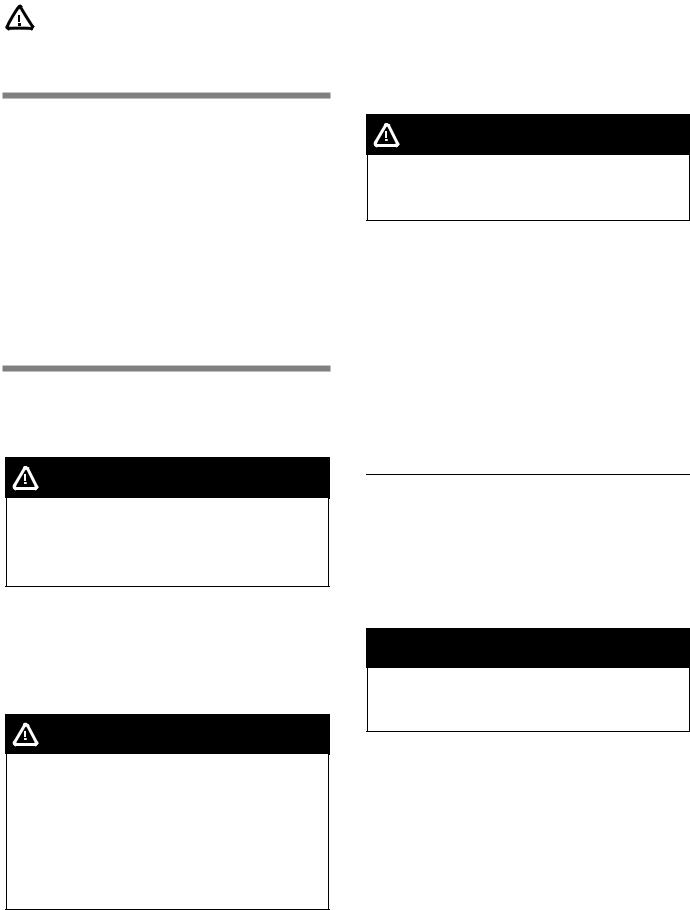
en-us
IMPORTANT SAFETY INSTRUCTIONS
READ AND SAVE THESE INSTRUCTIONS!
Scope of Delivery
After unpacking all parts, check for any damage in transit.
If there is damage, do not plug in your appliance. Please contact the dealer.
The following parts are included:
νFree-standing appliance
νInterior fittings (depending on model)
νBag containing installation materials
νOperating instructions
νInstallation instructions
νRegistration card
νInformation on energy consumption and noises
Installing the appliance
Have a qualified technician install and connect the appliance according to the enclosed Installation Instructions.
WARNING
Do not install the appliance:
νoutdoors,
νin an environment subject to drips of water,
νin rooms with risk of freezing temperatures.
Installation location
WARNING
Risk of explosion!
Do not install the appliance near explosive or flammable substances.
A dry, well-ventilated room is suitable as an installation location. The installation location should not be exposed to direct sunlight or placed near a heat source, e.g. a cooker, radiator, etc. If installation next to a heat source is unavoidable, use a suitable insulating plate or observe the following minimum distances from the heat source:
ν1Ê1/4I (3 cm) to electric or gas stoves.
ν11Ê3/16I (30 cm) to oil or solid fuel stoves.
To ensure that the Ice Maker functions correctly, the appliance must be upright and level.
Climatic classes
The climate class can be found on the rating plate. The climate class indicates within which ambient temperatures the appliance can be operated.
Climatic class |
|
Permitted ambient temperature |
|
|
|
|
|
SN |
50 |
°F to 90 °F (+10 °C to 32 °C) |
|
|
|
|
|
N |
61 |
°F to 90 °F (+16 °C to 32 °C) |
|
|
|
|
|
ST |
61 |
°F to 100 °F (+16 °C to 38 °C) |
|
|
|
|
|
T |
61 |
°F to 110 °F (+16 °C to 43 °C) |
|
|
|
|
|
Transporting
The appliance is heavy and must be secured during transport and installation.
The castors are provided for installation purposes only.
Do not use the castors for transporting the appliance.
WARNING
Risk of injury!
The appliance is very heavy. It can fall over and cause serious injuries during transport and installation. At least two people are required to install the appliance safely. Keep the refrigerator doors closed until the appliance is upright and level at the installation location.
Hidden surfaces may have sharp edges. Use caution when reaching behind or under appliance.
Subsurface
NOTICE
The appliance is very heavy.
The floor on which the appliance is to be installed must be rigid. Reinforce the floor, if necessary.
Ventilation
The refrigeration unit is ventilated only via the ventilation grille in the base. Never cover the ventilation grille or place anything in front of it. Otherwise the refrigeration unit must work harder, increasing the power consumption.
6

Aligning the appliance
NOTICE
Please kindly note there’s a bag inside the refrigerator compartment, which contains some accessories used for aligning the appliance (except user manual), including four supplied fastener-rings, three screws and one hex wrench.
NOTICE
To ensure that the appliance operates correctly, use a level to align the appliance.
If the appliance is not level, water may flow out of the ice maker, ice cubes may be irregular, or the doors may not close properly.
1.Place the appliance in the designated location.
2.So that the appliance cannot move, unscrew the two front feet until they are standing firmly on the floor.
3.Screw the feet in/out until the appliance is exactly level.
4.Use the level to check if the appliance is level.
NOTICE
To ensure that the appliance does not move, the front feet must be firmly planted on the floor.
5.If the height of the refrigerator compartment doors are uneven or if the freezer compartment drawer is slanted after adjusting the level of the appliance, use the following method to adjust them.
Adjusting the refrigerator doors
The appliance must be level in order to get the doors to align.
1.Raise the lower door up to the level of the higher door.
en-us
2.Insert the supplied fastener-ring (A) using a pair of pliers (B) in the gap between the
hinge-grommet (C) and the lower hinge (D). The number of fasten-rings you will need to insert depends on the gap.
B |
C |
A |
D |
Installing the base plate
1.Mount the base plate.
2.Insert the three screws and tighten (the screws are located in the manual kit).
Connecting the appliance
Have a technician install and connect the appliance according to the enclosed Installation Instructions.
Do not remove the transportation protection devices from the shelves and storage compartments until the appliance has been installed and aligned.
Always connect the water before the power.
Apart from statutory national regulations, you should comply with all applicable local electricity and water companies' codes and requirements.
After installing the appliance, wait at least 6 hours before switching the appliance on. During transportation the oil in the compressor may have flowed into the refrigeration system.
Before switching the appliance on for the first time, clean the interior of the appliance (see chapter “Cleaning the Appliance”).
7

en-us
Water connection
WARNING
Risk of electric shock and damage to the appliance!
Disconnect the appliance from the power source before performing any work on the water connection.
Only a qualified installation technician may connect the appliance to the water supply in accordance with plumbing and relevant water utility company regulations.
Connect the appliance to a drinking water line only:
νMinimum pressure:
0.17MPa (1.72 bar, 24.95 PSI)
νMaximum pressure:
0.82MPa (8.25 bar, 119.66 PSI)
νPressure over 0.82 MPa (8.25 bar, 119.66 PSI): install a pressure limiter between drinking water connection and hose set.
The water should be connected only by a competent plumber according to the local regulations of the appropriate Water Supply company.
A cold water connection is necessary for operating the ice maker. The water pressure must be between
0.17 MPa (1.72 bar, 24.95 PSI) and
0.82 MPa (8.25 bar, 119.66 PSI). The installation must correspond to the local plumbing regulations.
A separate Shut-Off-Valve should be installed in the cold-water inflow.
It is recommended that you mount the Shut-Off-Valve directly next to the appliance or at another place that is easily accessible.
When installing the water connection, pay attention to the permissible installation area for the water line.
For connection to the drinking water line use only water pipes that are suitable for drinking water. Observe national regulations and the connection conditions of the local Water Supply companies.
NOTICE
As the photo shows, there’s a water filter fixed and located inside the EPS put in the cavity of the refrigerator compartment. Please kindly note.
Water filter
8
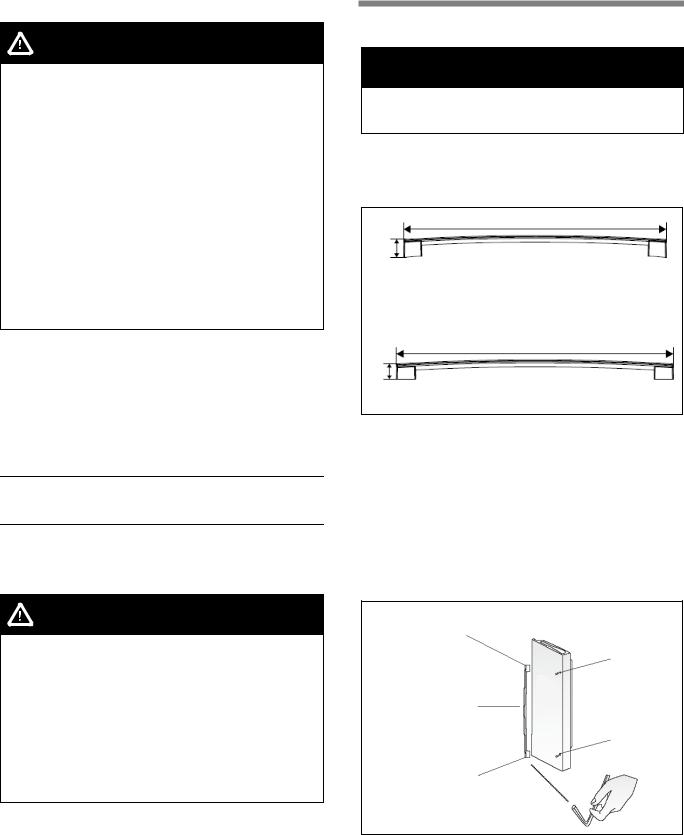
Electrical connection
WARNING
Risk of electric shock and fire if electrical connection is not installed properly!
Plug into a fixed, grounded 3-prong outlet only. The outlet must be installed and grounded according to code by a qualified electrician. If necessary, have the installation inspected by a qualified electrician to ensure it is properly grounded.
Never remove grounding conductor.
Do not use an extension cord, adapters or power strip.
Non-compliance with these instructions may result in death, fire or an electric shock. Improper connection of the grounding conductor may result in an electric shock. If you are in doubt whether the appliance has been grounded properly, have the appliance tested by a qualified electrician.
The receptacle must be installed according to the Installation Manual.
Connect the appliance to 115 V/60 Hz AC through a correctly installed 3-pole grounded receptacle. The receptacle must be protected with a 15 to 20 A fuse.
The appliance comes with a UL registered 3-wire Power Cord.
Please see the following table:
Appliance |
Maximum simultaneous load |
|
|
Fridge-freezer |
6.0 amps |
Check on the Rating Plate whether the indicated voltage and current type correspond with the values of your power supply. The location of the Rating Plate can be found in the chapter “Customer Service”.
WARNING
Never connect the appliance to electronic energy saving devices.
This appliance can be used with power line and sine-controlled inverters. Power line-controlled inverters are used for photovoltaic systems which are connected directly to the national grid. Sine-controlled inverters must be used for isolated applications (e.g. on ships or in mountain lodges) which are not connected directly to the national grid.
en-us
Installing the handles
NOTICE
Please remove protective film BEFORE installing handles.
Difference between the freezer and the refrigerator door handle
Handles are located inside of the carton box.
31.6˝ (803.8 mm)
2.1˝ |
Refrigerator door handle |
|
|
(54 mm) |
|
31.6˝ (802.3 mm)
2.1˝ Freezer door handle
(54 mm)
Refrigerator door handle
1.Take the refrigerator door handle out of the box and place it as per the direction shown in the figure (Note: i.e. the direction which both screw holes on the handle are close to the edge) and hang the handle above the set bolt.
2.Use the small hexagon wrench supplied in the box to set the handle screws into both the small screwed holes on the handle. After they are screwed down, gently shake the handle to confirm the handle is tightened.
Inner socket head cap screw for handle fixing
Bolt
Refrigerator door handle
Bolt
Inner socket head cap screw for handle fixing
Freezer door handle
The assembly steps of the freezer door handle are the same as the ones of the refrigerator door handle. During the assembly of the handle the direction of tapping hole is downward (towards the ground).
9
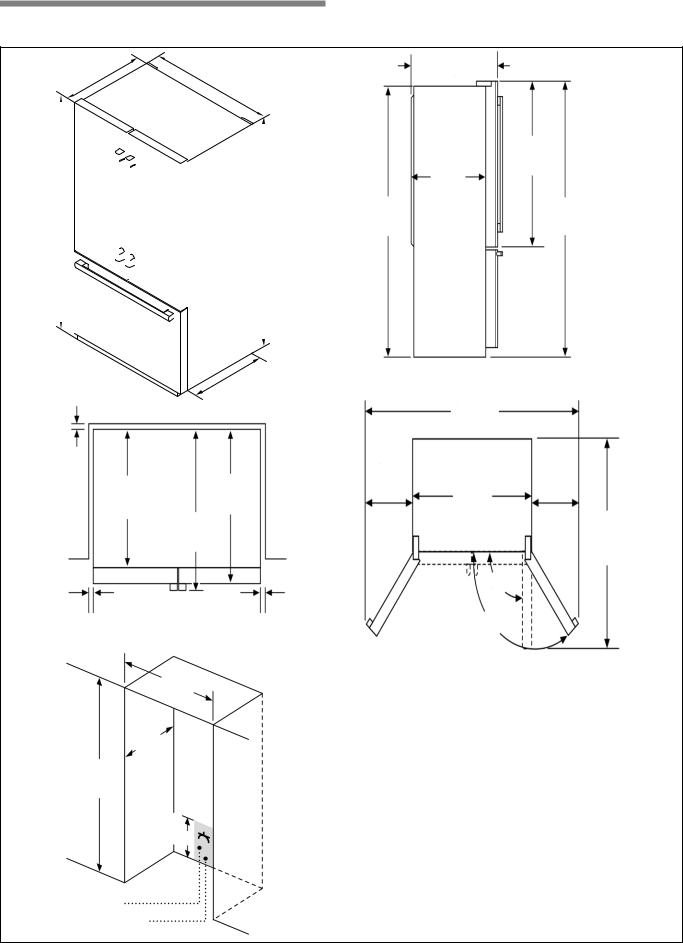
en-us
Appliance and Installation Dimensions
35 7/8"
(912)
69 7/8" |
|
|
|
|
|
|
|
|
|
|
|
68 5/8" |
|
|
|
|
|
|
|
|
|
|
|
||
|
|
|
|
|
|
|
|
|
|
|
||
|
|
|
|
|
|
|
|
|
|
|
||
|
|
|
|
|
|
|
|
|
|
|
||
(1775) |
|
|
|
|
|
|
|
|
|
|
|
(1742) |
|
|
|
|
|
|
|
|
|
|
|
|
|
|
|
|
|
|
|
|
|
|
|
|
|
|
|
|
|
|
|
|
|
|
|
|
|
|
|
|
|
|
|
|
|
|
|
|
|
|
|
|
|
|
|
|
|
|
|
|
|
|
|
|
|
|
|
|
|
|
|
|
|
|
|
|
|
|
|
|
|
|
|
|
|
|
|
|
|
|
|
|
|
|
|
|
|
|
|
|
|
|
|
|
|
|
|
|
|
|
|
|
|
|
|
|
|
|
|
|
|
|
|
|
|
|
|
|
|
|
24 5/8"
(625)
2"
(51)
24 |
5 |
/8" |
28 3/ |
4 |
" |
|
|
|
(625)(728.5)
30 3/4"
(782)
1/8" |
1/8" |
(3.2) |
(3.2) |
36" (914)
25"
(635)
70"
(1778)
23"
(584)
electrical water
28 3/4"
(728.5)
|
42" |
24 5/8" |
(1066) |
(625) |
|
68 5/8" |
69 7/8" |
(1742) |
(1775) |
64 3/8"
(1635)
14 3/8" |
|
14 3/8" |
(363.5) |
35 3/4" |
(363.5) |
|
(908) |
|
43 1/2"
(1103)
90°
135°
Leave 1/2" (12.7 mm) gap at the top and 2" (51 mm) behind the refrigerator for proper ventilation.
For installation next to a wall, leave
33/4" (95.2 mm) minimum on wall side for opening the door.
It is recommended that you do not install the refrigerator near a heat source such as an oven or a range.
Maximum receptacle and water line height 23" (584 mm).
measurements in inches (mm)
10
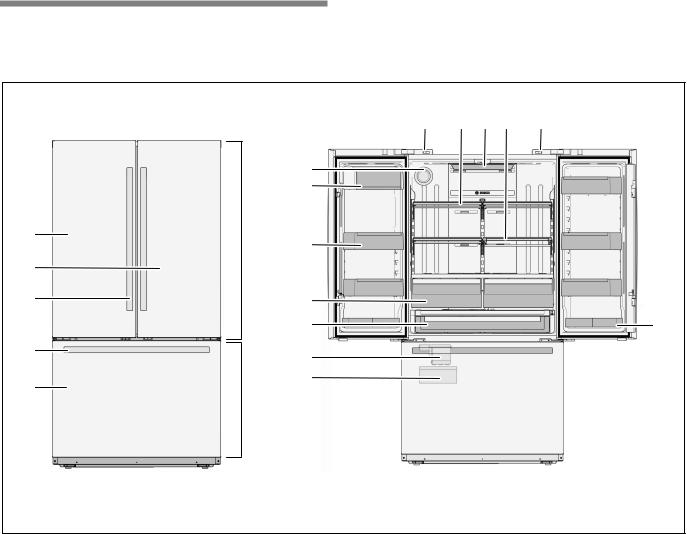
en-us
Getting to know your appliance
These operating and installation instructions apply to several models. The illustrations may differ from your particular model.
6 |
7 |
1 |
A |
|
|
8 |
|
2 |
|
|
3 |
9 |
|
|
10 |
|
4 |
11 |
|
|
||
5 |
12 |
|
B |
||
|
13 |
14 |
15 16 |
13 |
17 |
A |
Refrigerator compartment |
1 |
Left door for refrigerator compartment |
|
can be adjusted |
2 |
Right door for refrigerator compartment |
|
between 34 °F (+1 °C) |
3 |
Door handle |
|
and 44 °F (+7 °C) |
4 |
Drawer handle |
B |
Freezer compartment |
5 |
Freezer drawer |
|
can be adjusted |
6 |
Water filter |
|
between 9 °F (-13 °C) |
7 |
Dairy bin |
|
and -8 °F (-22 °C) |
8 |
Door bin |
|
|
9 |
Crisper drawers |
|
|
10 |
Chiller drawer |
|
|
11 |
Ice maker |
|
|
12 |
Ice storage box |
|
|
13 |
Switch for refrigerator compartment lamp |
|
|
14 |
Adjustable shelf |
|
|
15 |
Control and display panel |
|
|
16 |
Retractable Shelf |
|
|
17 |
Small tray |
11
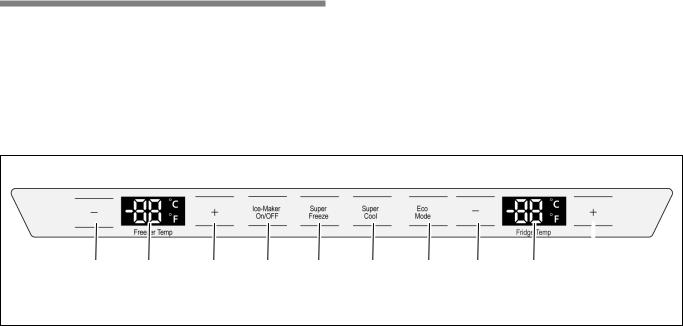
en-us
Control and display panel
Display
After the appliance is switched on and the refrigerator door is opened, the display panel light illuminates and stays lit up for 30 seconds. Then the lights go out.
Display control
After 30 seconds with no actions for door opening and no button operation the display panel light will go out. Every time the door is opened, closed or the display is touched, the display panel returns to normal.
1 |
2 |
3 |
4 |
5 |
6 |
7 |
8 |
9 |
10 |
1“Freezer Temp. –” button
Button for down-regulation of the temperature in the freezer compartment
2Freezer compartment temperature display
Displays the temperature set for the freezer compartment.
3“Freezer Temp. +” button
Button for up-regulation of the temperature in the freezer compartment
4”Ice Maker On/OFF” button
Button for switching the ice maker on and off.
5“Super Freeze” button
Button for switching the ”Super freeze” function on and off.
6“Super Cool” button
Button for switching the ”Super Cool” function on and off.
7”Eco Mode” button
Button for switching the Eco Mode on and off.
8”Fridge Temp. –” button
Button for down-regulation of the temperature in the refrigerator compartment
9Refrigerator compartment temperature display
Displays the temperature set for the refrigerator compartment.
10”Fridge Temp. +” button
Button for up-regulation of the temperature in the refrigerator compartment
12

Operating tips
Opening and closing the refrigerator compartment doors
The refrigerator compartment doors can be opened and closed independently.
The left refrigerator compartment door has a foldaway door bar.
NOTICE
Risk of damage to the appliance!
The door bar could become damaged if you attempt to close the left refrigerator compartment door when the door bar is not folded back.
Before closing the refrigerator compartment doors, make sure that the door bar is folded at a right angle to the door.
When closing the left refrigerator compartment door, the door bar folds behind the right refrigerator compartment door, forming a seal between the refrigerator compartment doors.
en-us
Switching on the appliance
NOTICE
After installing the appliance, wait at least 6 hours before plugging in the appliance. The oil in the compressor may have flowed into the refrigeration system during transport.
Connect the appliance plug to the outlet.
After the appliance has been plugged in, the refrigeration process will begin. The interior light in the refrigerator compartment switches on when the door is open.
It will take several hours for the inside of the appliance to reach the temperatures set at the factory. Do not place food in the appliance until these temperatures are reached.
Initial temperature
Refrigerator compartment: 39 °F (+4 °C)
Freezer compartment: 0 °F (-18 °C).
Setting the temperature
Freezer compartment
The temperature can be adjusted between 9 °F (-13 °C) up to -8 °F (-22 °C).
1.Press the “Freezer Temp. –" or the “Freezer Temp. +" button.
The freezer compartment temperature illuminate.
2.Repeatedly press the “Freezer Temp. –" or the “Freezer Temp. +" button until the desired freezer compartment temperature is set.
The temperature cannot be set circularly; every time the temperature will increase by 1 °F (1 °C) after the button is pressed once.
After the temperature adjustment is completed, the new temperature setting will be active for 15 seconds after button was pressed.
We recommend a setting of 0 °F (-18 °C).
13
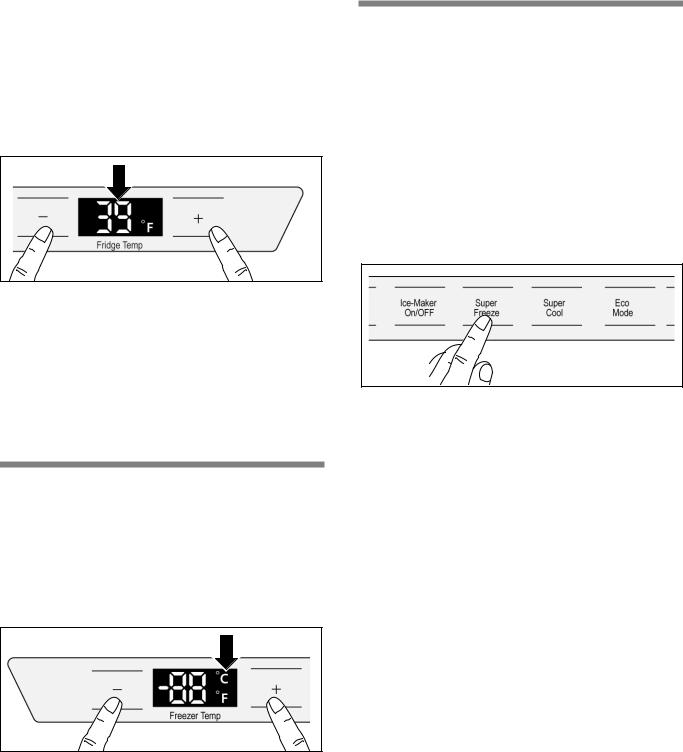
en-us
Refrigerator compartment
The temperature can be adjusted between 34 °F (+1 °C) up to 44 °F (+7 °C).
1.Press the "Fridge Temp. –" or the "Fridge Temp. +" button.
The refrigerator compartment temperature illuminate.
2.Repeatedly press the "Fridge Temp. –" or the "Fridge Temp. +" button until the desired refrigerator compartment temperature is set.
The temperature cannot be set circularly; every time the temperature will increase by 1 °F (1 °C) after the button is pressed once.
After the temperature adjustment is completed, the new temperature setting will be active for 15 seconds after button was pressed.
We recommend a setting of 39 °F (+4 °C).
Perishable foods should not be stored at temperatures higher than 39 °F (+4 °C).
Temperature unit
The temperature can be displayed in degrees Fahrenheit (°F) or Celsius (°C).
After the appliance is switched on, the temperature appears in degrees Fahrenheit (°F).
To set the temperature unit:
Press the “Freezer Temp. –" and the “Freezer Temp. +" button for 3 seconds.
The temperature unit switches.
Super Freeze
Food should be frozen as quickly as possible in order to retain their vitamins, nutritional value, appearance and flavor.
To prevent an undesirable rise in temperature when placing fresh food in the freezer compartment, switch on Super Freeze several hours beforehand.
As a rule, 4 to 6 hours is adequate. Allow for a minimum of 24 hours if planning to use the maximum freezing capacity.
Smaller quantities of food can be frozen without Super Freeze.
To switch on Super Freeze:
Press the ”Super Freeze” button.
The corresponding button lamp lights up.
The temperature is set to -8 °F (-22 °C).
To switch off Super Freeze:
Press the ”Super Freeze” button.
The corresponding button lamp goes out.
After 6 hours Super Freeze mode will turn off automatically.
14

Super Cool
Super Cool cools the refrigerator compartment down as low as possible.
Super Cool is particularly recommended for the following:
νBefore placing large quantities of food in the refrigerator compartment.
νTo cool drinks quickly.
To switch on Super Cool:
Press the ”Super Cool” button.
The corresponding button lamp lights up.
The temperature is set to 34 °F (+1 °C).
To switch off Super Cool:
Press the ”Super Cool” button.
The corresponding button lamp goes out.
After 2.3 hours, Super Cool mode will turn off automatically.
Eco Mode
This mode is for going on vacation or not using the refrigerator for a long period of time.
The temperature of refrigerator compartment is automatically set to 44 °F (7 °C) and the temperature of the freezer compartment is set to 5 °F (-15 °C).
To switch on Eco Mode:
Press the ”Eco Mode” button.
The corresponding button lamp lights up.
To switch off Eco Mode:
Press the ”Eco Mode” button.
The corresponding button lamp goes out.
en-us
Refrigerator compartment
WARNING
Risk of explosion!
Do not store explosive substances in the appliance.
The Refrigerator compartment is the ideal storage location for ready meals, cakes and pastries, preserved food, condensed milk, milk, cheese, spreads, sauces, dips and eggs.
When purchasing food, please note
The freshness at point of purchase is important for the shelf-life of your food. In principle, the fresher the produce when placed in the crisper drawers, the longer it stays fresh. Therefore, when buying food, always pay attention to the degree of freshness.
Observe the expiration date specified by the manufacturer for ready products and bottled products.
Arranging Food in the Appliance
νWrap or cover food before placing in the appliance. This will retain the aroma, color and freshness of the food. In addition, flavors will not be transferred between foods and the plastic parts in the appliance will not become discolored.
νAllow warm food and drinks to cool down before placing in the appliance.
νDo not block air outlet openings with food in the refrigerator compartment, otherwise the air circulation will be impaired. Food which is stored directly in front of the air outlet openings may be frozen by the cold air flowing out.
νAvoid contact of oil and fat with the plastic parts and door seal.
15
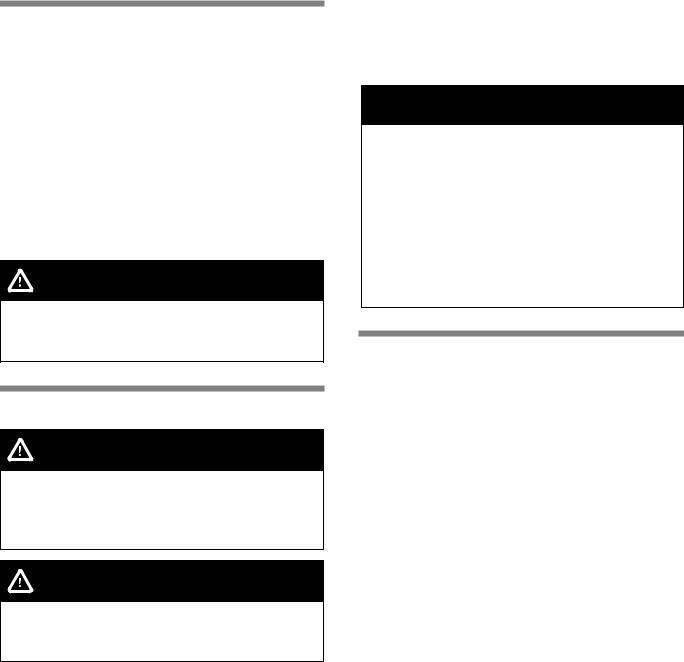
en-us
Fresh food compartment
The following foods are suitable for keeping in the fresh food compartment
νFish, seafood, meat, sausage and cold meats, dairy products, ready meals
νVegetables (e.g. carrots, asparagus, celery, leeks, beetroot, mushrooms, cabbage, broccoli, cauliflower, sprouts, kohlrabi)
νLettuce varieties (e.g. lamb's lettuce, iceberg, chicory, round lettuce)
νHerbs (e.g. dill, parsley, chives, basil)
νFruit (varieties not sensitive to cold, e.g. apples, peaches, berries, grapes).
CAUTION
After power failure or disconnection of the appliance from the power source, the temperature of the fresh food compartment must be readjusted.
Freezer compartment
WARNING
Risk of explosion!
Never store products containing flammable propellants (such as spray cans) or explosive or easily combustible substances in the appliance.
CAUTION
Do not refreeze thawing or thawed food. Never keep frozen food longer than the maximum storage duration.
Using the freezer compartment
νTo store deep-frozen food.
νTo freeze food.
νTo make and store ice cubes.
NOTICE
Make sure that the freezer compartment drawers are always kept closed. The frozen food will thaw if the freezer compartment drawers are open. The freezer compartment will become covered with thick ice. Also: Energy will be lost due to high power consumption.
When the freezer compartment drawers are closed, low pressure occurs inside the compartment.
If you cannot reopen the freezer compartment drawers right away, wait two to three minutes until the low pressure has adjusted itself.
Freezing food
Purchasing Frozen Food
νPackaging must not be damaged.
νUse by the “expiration” date.
νTemperature in the supermarket freezer must be 0 °F (-18 °C) or lower.
νIf possible, transport deep-frozen food in an insulated bag and place immediately in the Freezer Compartment.
16

Freezing fresh food
Freeze fresh and undamaged food only.
To retain the best possible nutritional value, flavor and color, vegetables should be blanched before freezing. Eggplants, peppers, zucchini and asparagus do not require blanching.
Literature on freezing and blanching can be found in bookshops.
NOTICE
Keep food that is to be frozen away from food that is already frozen.
νThe following foods are suitable for freezing: Cakes and pastries, fish and seafood, meat, game, poultry, vegetables, fruit, herbs, eggs without shells, dairy products such as cheese, butter and quark, and ready meals and leftovers such as soups, stews, cooked meat and fish, potato dishes, soufflés and desserts.
νThe following foods are not suitable for freezing: Types of vegetables that are usually consumed raw such as lettuce or radishes, eggs in shells, grapes, whole apples, pears and peaches, hard-boiled eggs, yogurt, butter milk, sour cream, crème fraîche and mayonnaise.
Packing Frozen Food
To prevent food from losing its flavor or drying out, place in airtight containers.
1.Place food in packaging.
2.Remove air.
3.Seal the wrapping.
4.Label packaging with contents and date of freezing.
Suitable Packaging:
Cling wrap, polyethylene hose film, aluminum foil, freezer containers. These products are available from specialist outlets.
Unsuitable Packaging:
Wrapping paper, greaseproof paper, cellophane, bin liners and used shopping bags.
Items Suitable for Sealing Packaged Food:
Rubber bands, plastic clips, string, cold-resistant adhesive tape, etc. Bags and tubular film made of polyethylene can be sealed with a film heat sealer.
Storage life of frozen food
The storage life depends on the type of food. At a temperature setting of 0 °F (-18 °C):
νFish, sausage, ready meals, cakes and pastries: up to 6 months
νCheese, poultry and meat: up to 8 months
νFruit and vegetables: up to 12 months.
en-us
Thawing frozen food
CAUTION
Risk of poisoning!
Do not refreeze food that is beginning to thaw or has already thawed. The food cannot be refrozen until it has been prepared (boiled or fried). Do not store these refrozen products for the maximum storage period.
Depending on the type of food and its intended use, frozen food can be thawed as follows:
νin the refrigerator compartment
νin an electric oven with/without fan-assisted hot air
νin the microwave.
Ice maker
The ice maker makes ice cubes.
When the ice storage box is full, the ice maker stops ice production automatically.
The ice maker is capable of producing 2.8 - 3.3 lb (1.3 - 1.5 kg) of ice in 24 hours depending on the temperature of freezer compartment, surrounding temperature, frequency of door opening/closing and other working conditions.
Points to observe when switching on for the first time
The ice maker only functions when the appliance is connected to the water supply.
The ice maker starts to make ice cubes as soon as the appliance has reached the set temperature.
When using the ice maker for the first time, do not use the first 30 to 40 ice cubes for reasons of hygiene.
17
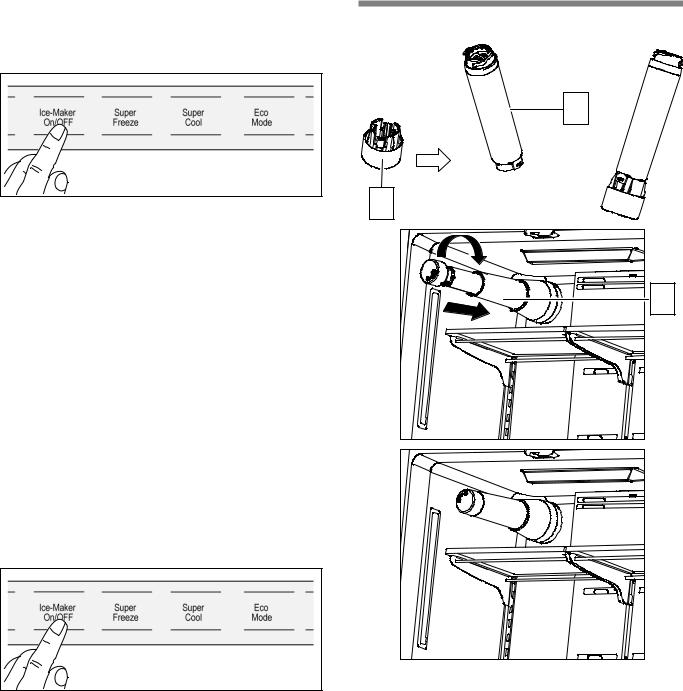
en-us
Switching on
1.Make sure that ice storage box is in its place and locked into position.
2.Press the ”Ice Maker On/OFF” button.
Water filter
2.
B = |
B |
The corresponding button lamp lights up.
Before the ice maker is switched on again after a long period, clean the ice cube maker and the ice storage box.
When the ice maker is switched on, the temperature for the freezer compartment automatically shown on the display is 0° F ( 18 °C).
Notes on using the ice-maker
You will hear the sound of the motor after about two hours. This is the sound of the valve providing water to the ice maker and does not indicate a malfunction.
It is normal that several ice cubes may stick together or get crushed.
Ice making takes longer if you open the drawer frequently.
Switching off
Before switching the ice maker off, it is most important that you switch the water supply to the appliance off for a few hours.
1. Press the ”Ice Maker On/OFF” button.
The corresponding button lamp goes out.
2.Taking out and cleaning the ice storage box.
3.Taking out and cleaning the ice cube box.
A |
A |
|
C |
|
2. |
3. |
1.Remove water filter B from box.
2.Attach A (cap) onto to B (filter) (refer to picture above)
3.With A (cap) end facing you, insert the combined A-B unit from Step 2 into housing C and rotate clockwise (approximately ¾ turn) until it is locked into place. Do not over-rotate.
4.We recommend changing the filter every 6 months. When the filter has expired, turn knob counterclockwise until is loose and pull straight out. A small amount of water may drip out during the transition so we recommend having a towel available.
5.Remove cap A from old water filter and discard the old filter.
6.Repeat steps 1-3 to install the new filter. Use a permanent marker to write the filter change date on the new filter.
18
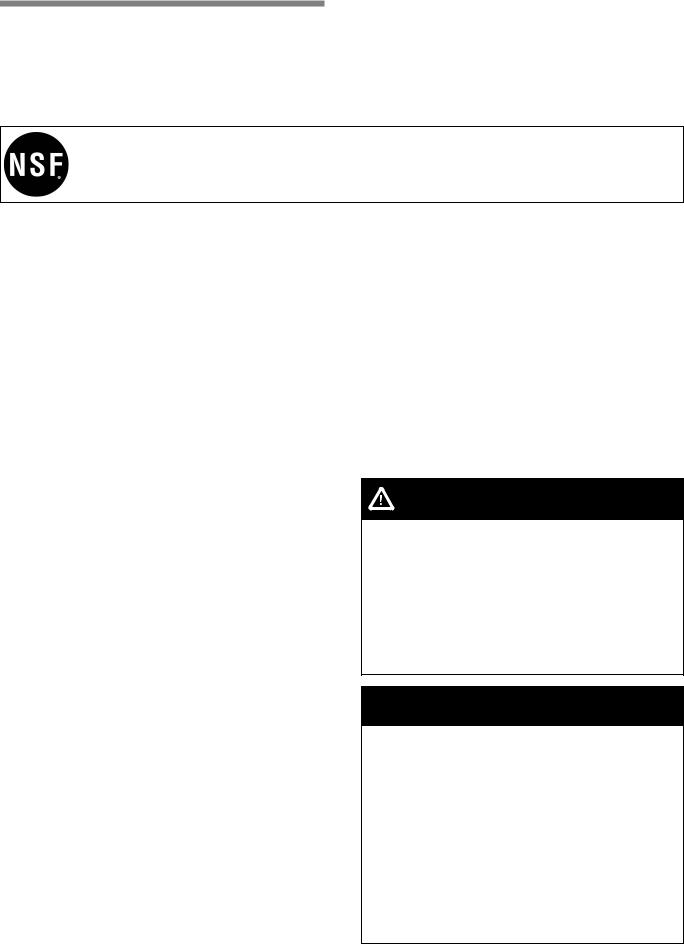
en-us
Performance data sheet
Model: 9000 077 508, 9000 705 475 and 9000 225 170
Use Replacement Cartridge 9000 674 655
The concentration of the indicated substances in water entering the system was reduced to a concentration less than or equal to the permissible limit for water leaving the system as specified in NSF/ANSI Standard 42 and Standard 53.
System tested and certified by NSF International against NSF/ANSI Standard 42 and Standard 53 for the reduction of the claims specified on the Performance Data Sheet.
Capacity 739.68 Gallons (2,800 Liters)
Contaminant Reduction Determined by NSF testing.
Contaminant |
Average |
NSF specified |
Avg % |
Average |
Max |
NSF |
NSF Test |
Reduction |
Influent |
Challenge |
Reduction |
Product Water |
Permissible |
Reduction |
Report |
|
|
Concentration |
|
Concentration |
Product |
Require- |
|
|
|
|
|
|
Water |
ments |
|
|
|
|
|
|
Concen- |
|
|
|
|
|
|
|
tration |
|
|
Chlorine Taste |
2.1 mg/L |
2.0 mg/L |
97.6 % |
0.05 mg/L |
N/A |
w 50 % |
J-00121313 |
and Odor |
|
±10 % |
|
|
|
|
|
Nominal |
9,100,000 |
At least 10,000 |
98.8 % |
111,817 pts/ml |
N/A |
w 85 % |
J-00099871 |
Particulate |
pts/mL |
particles/mL |
|
|
|
|
|
Class I, |
|
|
|
|
|
|
|
w 0.5 to < 1.0 |
|
|
|
|
|
|
|
μm |
|
|
|
|
|
|
|
Cysts * |
170,000 |
Minimum |
99.99 % |
0.001 cyst/L |
N/A |
w 99.95 % |
J-00109715 |
|
cysts/L |
50,000 cysts/L |
|
|
|
|
|
* Based on the use of Cryptosporidium parvum oocysts.
Application Guidelines/Water Supply Parameters
Service flow |
0.75 gpm (2.83 lpm) |
|
Water Supply |
Potable Water |
|
Water pressure |
30 |
- 120 psi (207 – 827 kPa) |
Water |
33 |
°F - 100 °F (0.6 °C – 38 °C) |
temperature |
|
|
It is essential that the manufacturer’s recommended installation, maintenance and filter replacement requirements be carried out for the product to perform as advertised. See Installation Manual for Warranty information.
Note: While the testing was performed under standard laboratory conditions, actual performance may vary.
Replacement Cartridge: 9000 674655. For estimated costs of replacement elements please contact your local dealer or call 1-800-578-6890.
WARNING
To reduce the risk associated with ingestion of contaminants:
DO NOT use this product with water that is microbiologically unsafe or of unknown quality without adequate disinfection before or after connection to the system. Systems certified for cyst reduction may be used in disinfected water that may contain filterable cysts.
EPA Establishment Number 10350-MN-005
NOTICE
To reduce the risk associated with property damage due to water leakage or flooding:
Read and follow all Instructions before installation and use of this system.
To reduce the risk of water leakage or flooding, and to ensure optimal filter performance:
Change the disposable filter cartridge every six months or sooner if you observe a noticeable reduction in water flow rate.
Failure to replace the disposable filter cartridge at recommended intervals may lead to reduced filter performance and cracks in the filter housing, causing water leakage or flooding.
19
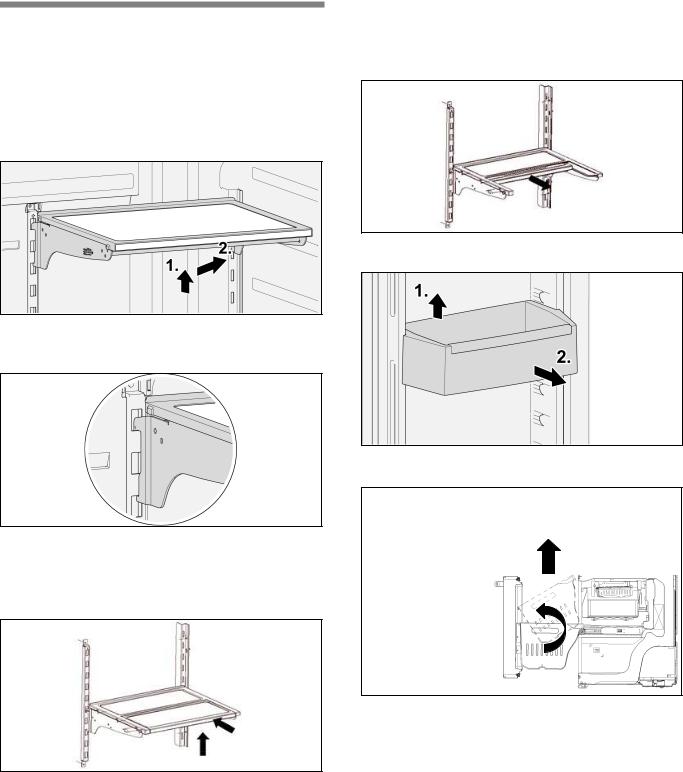
en-us
Interior Fittings
Adjustable Shelf
The Adjustable Shelf can be adjusted to the proper height required by various food items.
Adjusting
Tilt the shelf upward, raise it and pull it out towards you.
During installation, put the upper end of the fixed leg into the desired slot. Lower the shelf. The lower end of the fixed leg engages into a lower slot.
Unfolding
Pull out the retractable glass shelf directly until it is at the fore-end level of fixed glass shelf, then the buckle of retractable glass shelf will drop into the slot of fixed shelf and will not withdraw due to factor of gravity.
Door bin
Lower freezer drawer
Retractable Shelf
Folding
Put fore-end of the retractable glass shelf up until it coincides with rear-end.
2.
1.
1.First open the left and right door of refrigerator.
2.Open the freezer compartment door.
3.Rotate 90 degrees in the direction 1 and then remove the lower freezer drawer in the direction 2.
20
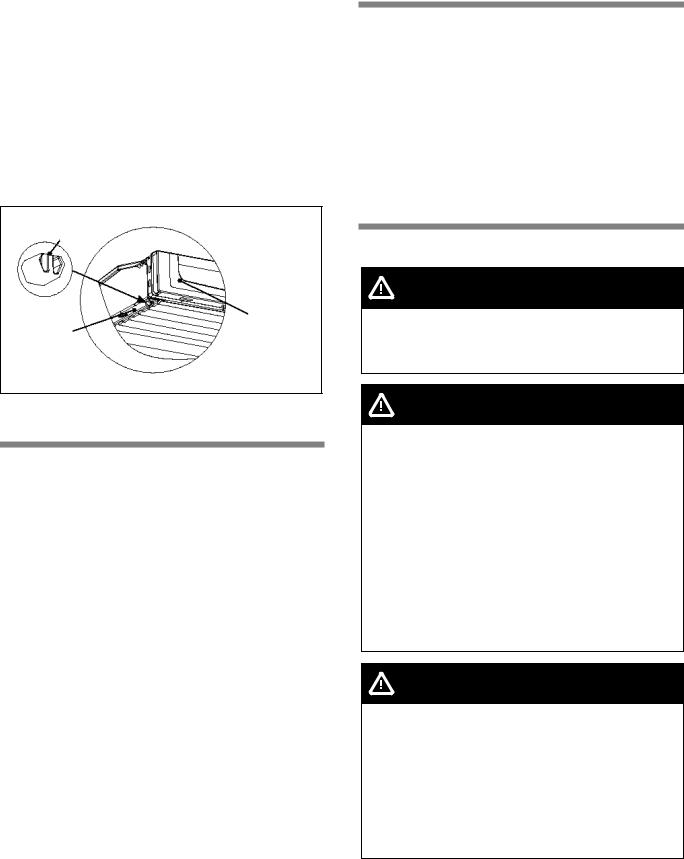
Chiller Drawer
The Chiller Drawer has a maximum load of 22 lb (10 kg).
Pulling out and installing the Chiller Drawer
1.Pull out the Chiller Drawer.
2.Find the hooks at the left and right sides at the drawer bottom (shown in the figure).
3.Hold the hook at two sides with a nose pliers and push it up and out of the groove of sliding rail and take out the hook at the other side with the same method.
4.Take out the drawer.
Hook
Chiller Drawer
Sliding rail
5. Install the drawer by putting the hook into the slots.
Switching off and disconnecting the appliance
Switching off the appliance
Unplug the appliance or switch off the fuse.
Disconnecting the appliance
If the appliance is not used for an extended period of time:
1.It is imperative that you disconnect the water supply to the appliance for a few hours before switching off the appliance.
2.Remove all food from the appliance.
3.Unplug the appliance.
4.Empty and clean the ice maker and the ice storage box.
5.Clean the appliance interior (see ”Cleaning the appliance”).
en-us
Defrosting
Freezer compartment
The fully automatic Nofrost system ensures that the freezer compartment remains free of ice. Defrosting is not required.
Refrigerator compartment
Defrosting takes place automatically.
The condensation runs through the drainage hole into an evaporation pan at the rear of the appliance.
Cleaning
WARNING
Risk of electric shock!
Unplug the appliance or turn off the circuit breaker or fuse before cleaning the appliance.
CAUTION
To avoid personal injury or damage to property, observe the following:
Never use a steam cleaner to clean the appliance.
Do not use abrasive or acidic cleaning agents or solvents.
Wipe lights and the control and display panel with a damp cloth only. Do not let water used for cleaning drip into the lights or onto the control and display panel.
Do not let cleaning water run into the drainage hole in the evaporation area.
Never clean shelves and containers in a dishwasher. The parts may warp.
CAUTION
For cleaning the Black Stainless Steel we advise using a soft and dry towel. If the dirt on the surface is not easy to clean/to remove only with a soft dry towel, we advise to use warm water diluted with a neutral cleansing agent.
Never use stainless steel cleaner.
Use only a non-abrasive, mild cleansing soap and water solution for cleaning the Black Stainless Steel.
21
